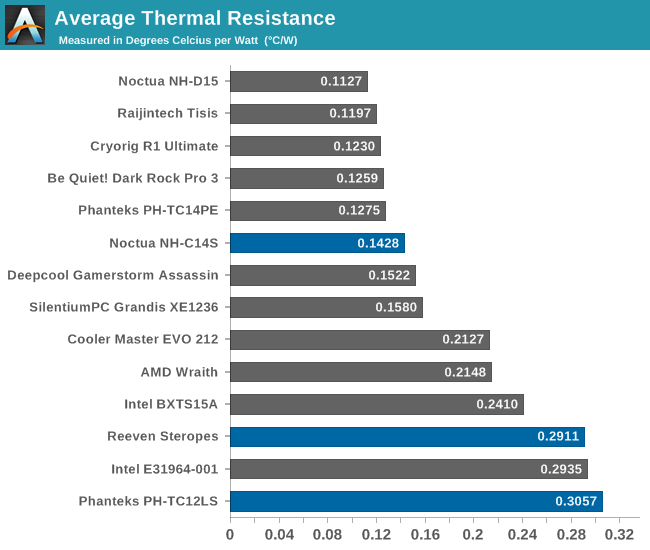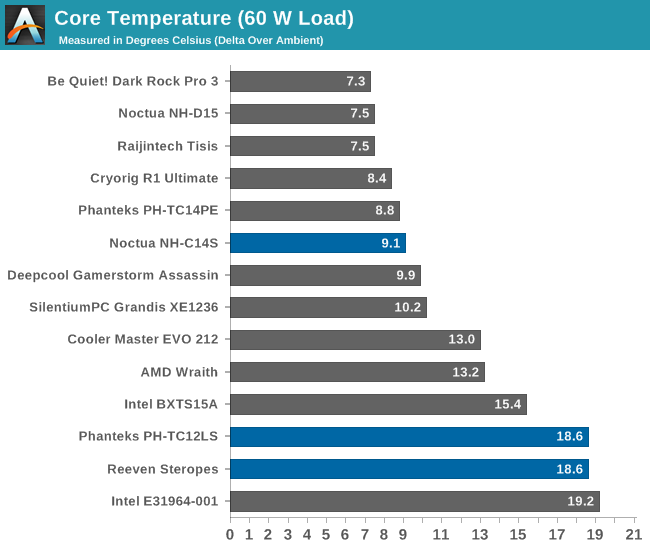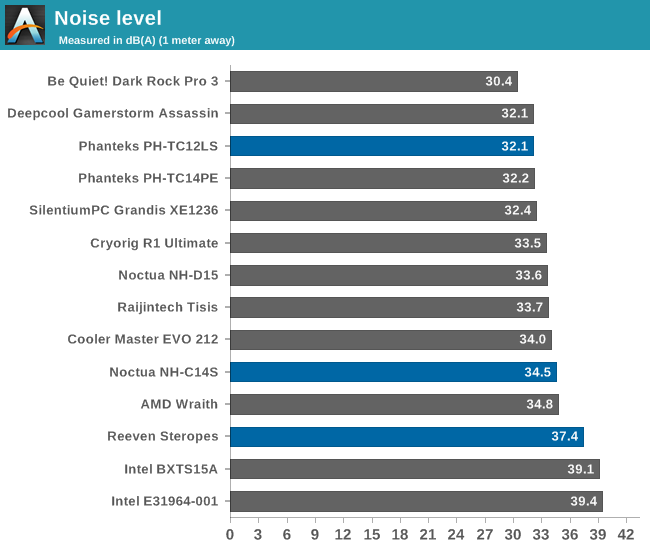3-Way Low Profile CPU Cooling Shoot-Out: Reeven, Phanteks, & Noctua
by E. Fylladitakis on January 18, 2017 8:00 AM EST- Posted in
- Cases/Cooling/PSUs
- Noctua
- Phanteks
- Cooler
- Reeven
Testing Results, Low Fan Speed (7 Volts)
Switching things up, let's take a look at cooling performance with the fans brought down to 7 Volts, for a look at performance with quieter operation.

As you'd expect, the average thermal resistance rises with the reduced airflow. The Noctua is still in a league of its own here due to its size. Meanwhile the Phanteks struggles some, as it comes in at the bottom of this chart.

| Core Temperature, Constant Thermal Load (Low Fan Speed) |
Core temperatures still look good, though. With the Noctua well in the lead, the other two coolers are only about 19C over ambient at 60W, which bodes particularly well for quiet computing at stock clocks.


While we had to skip two of our highest wattage tests here - these low profile coolers simply aren't meant for highly overclocked & overvolted processors - ultimately the results from our tests show that all of the coolers are sufficient for their jobs. Though smaller, neither the Phanteks or Reeven coolers would have any issue cooling a modern processor running at stock speed, even in low airflow environments. Again, the Reeven Steropes has the advantage over the Phanteks TC12LS in terms of raw thermal performance, but the latter is significantly quieter, reaching virtually inaudible noise levels.
As for the Noctua NH-C14S, with its fans running at low speed, the performance gap between the NH-C14S and the other horizontal coolers widened greatly, to the point that it would be unfair to make any comparisons at all. The NH-C14S is only comparable to large tower coolers, thermally outperforming even very large coolers with much greater mass. The noise output of the NF-A14 fan under these conditions is very low and should be barely noticeable in a very quiet room.










43 Comments
View All Comments
StevoLincolnite - Wednesday, January 18, 2017 - link
<3 Noctua.Samus - Wednesday, January 18, 2017 - link
The Noctua, although taller, has the best design. Inverting the fan is pretty smart.StevoLincolnite - Wednesday, January 18, 2017 - link
They also tend to be more expensive. But the cost is worth it in my opinion.nagi603 - Thursday, January 19, 2017 - link
Yes, they actually do provide far better workmanship and package. First Noctua I bought after Scythe blew me away, though it did cost twice the money.nathanddrews - Wednesday, January 18, 2017 - link
Great timing, AT! I was just looking at some low profile HSF solutions for a SFF AMD ITX system I have kicking around. The case I'm using has about 70mm clearance IIRC, so I was looking at the Noctua NH-L9a, but I'll have to see if the other dimensions of the Reeven will work in that space.80-wattHamster - Wednesday, January 18, 2017 - link
Cryorig's C7 is a good ~100W option as well, speaking as an owner of one. The fan it shipped with did have some PWM noise, but Cryorig's CS was helpful and sent a replacement (which is flawless so far) with minimal fuss.wolfemane - Wednesday, January 18, 2017 - link
I've currently got a c7 in my Node 202 build cooling a 6600k. It barely does the job and after two replacement fans, I've finally given up on the fan side. I still use the base but I've custom mounted a 120mm sp fan to it and have seen much better temps. But still not that great. The L9i could t cut it either, which I had on prior to the c7. I've got a scythe big shuriken rev. B on the way to try out.80-wattHamster - Wednesday, January 18, 2017 - link
A 6600K with an overclock definitely pushes a C7 pretty hard. It keeps mine under control at 4.0, though stress testing does start to push the thermal limit.nathanddrews - Thursday, January 19, 2017 - link
You guys talking about the AMD A8-6600K or the Intel i5-6600K?80-wattHamster - Thursday, January 19, 2017 - link
Good question! Intel in my case.